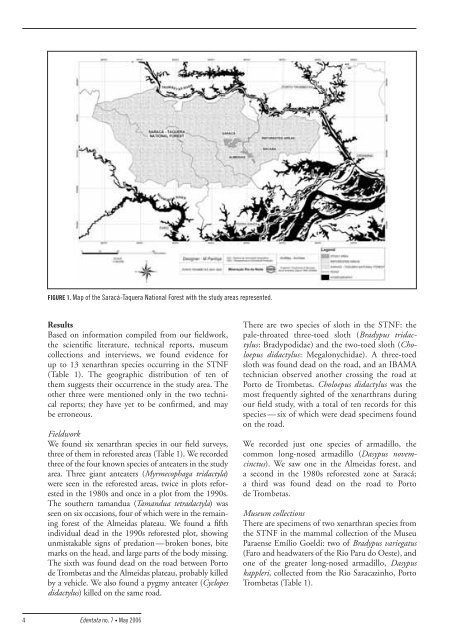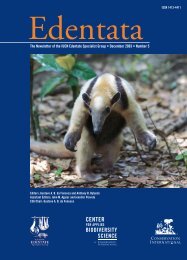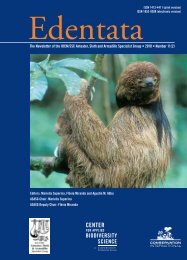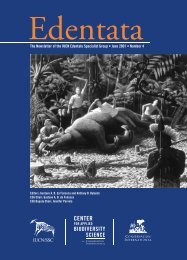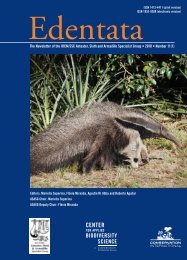Edentata 7 - Anteater, Sloth & Armadillo Specialist Group
Edentata 7 - Anteater, Sloth & Armadillo Specialist Group
Edentata 7 - Anteater, Sloth & Armadillo Specialist Group
- No tags were found...
You also want an ePaper? Increase the reach of your titles
YUMPU automatically turns print PDFs into web optimized ePapers that Google loves.
FIGURE 1. Map of the Saracá-Taquera National Forest with the study areas represented.<br />
Results<br />
Based on information compiled from our fieldwork,<br />
the scientific literature, technical reports, museum<br />
collections and interviews, we found evidence for<br />
up to 13 xenarthran species occurring in the STNF<br />
(Table 1). The geographic distribution of ten of<br />
them suggests their occurrence in the study area. The<br />
other three were mentioned only in the two technical<br />
reports; they have yet to be confirmed, and may<br />
be erroneous.<br />
Fieldwork<br />
We found six xenarthran species in our field surveys,<br />
three of them in reforested areas (Table 1). We recorded<br />
three of the four known species of anteaters in the study<br />
area. Three giant anteaters (Myrmecophaga tridactyla)<br />
were seen in the reforested areas, twice in plots reforested<br />
in the 1980s and once in a plot from the 1990s.<br />
The southern tamandua (Tamandua tetradactyla) was<br />
seen on six occasions, four of which were in the remaining<br />
forest of the Almeidas plateau. We found a fifth<br />
individual dead in the 1990s reforested plot, showing<br />
unmistakable signs of predation — broken bones, bite<br />
marks on the head, and large parts of the body missing.<br />
The sixth was found dead on the road between Porto<br />
de Trombetas and the Almeidas plateau, probably killed<br />
by a vehicle. We also found a pygmy anteater (Cyclopes<br />
didactylus) killed on the same road.<br />
There are two species of sloth in the STNF: the<br />
pale-throated three-toed sloth (Bradypus tridactylus:<br />
Bradypodidae) and the two-toed sloth (Choloepus<br />
didactylus: Megalonychidae). A three-toed<br />
sloth was found dead on the road, and an IBAMA<br />
technician observed another crossing the road at<br />
Porto de Trombetas. Choloepus didactylus was the<br />
most frequently sighted of the xenarthrans during<br />
our field study, with a total of ten records for this<br />
species — six of which were dead specimens found<br />
on the road.<br />
We recorded just one species of armadillo, the<br />
common long-nosed armadillo (Dasypus novemcinctus).<br />
We saw one in the Almeidas forest, and<br />
a second in the 1980s reforested zone at Saracá;<br />
a third was found dead on the road to Porto<br />
de Trombetas.<br />
Museum collections<br />
There are specimens of two xenarthran species from<br />
the STNF in the mammal collection of the Museu<br />
Paraense Emílio Goeldi: two of Bradypus variegatus<br />
(Faro and headwaters of the Rio Paru do Oeste), and<br />
one of the greater long-nosed armadillo, Dasypus<br />
kappleri, collected from the Rio Saracazinho, Porto<br />
Trombetas (Table 1).<br />
4<br />
<strong>Edentata</strong> no. 7 • May 2006


